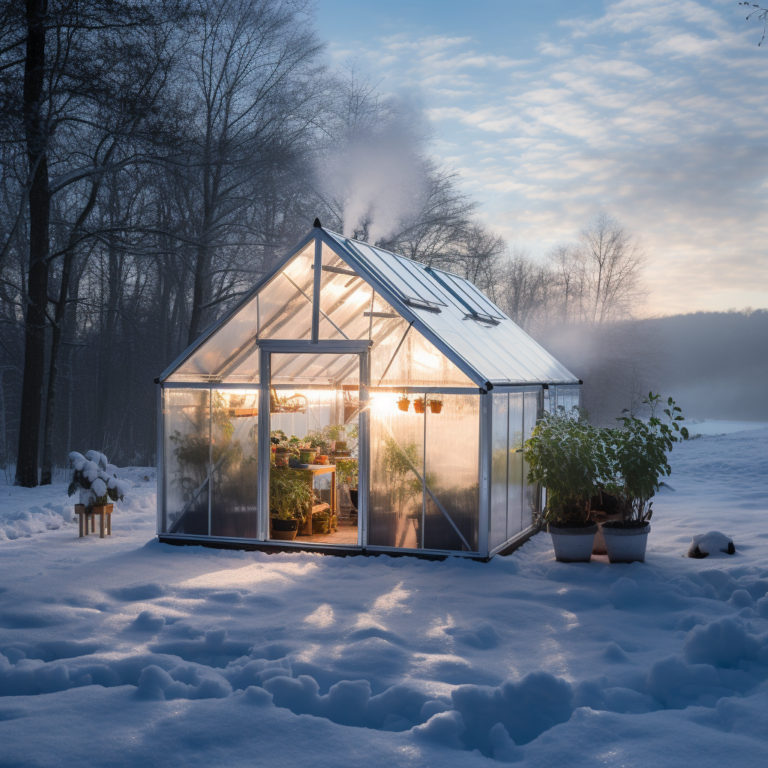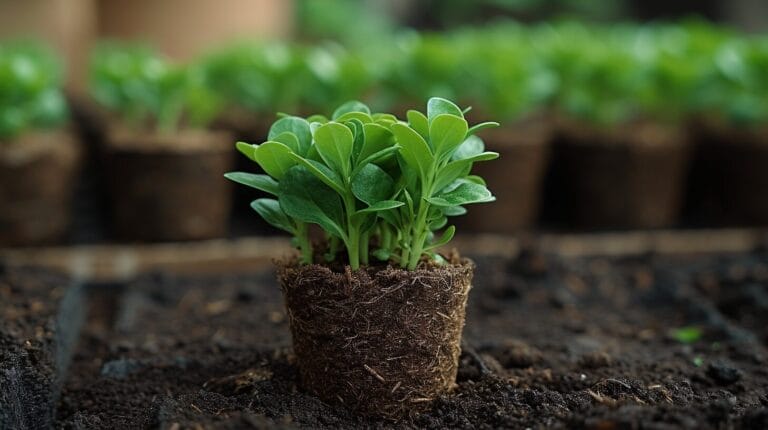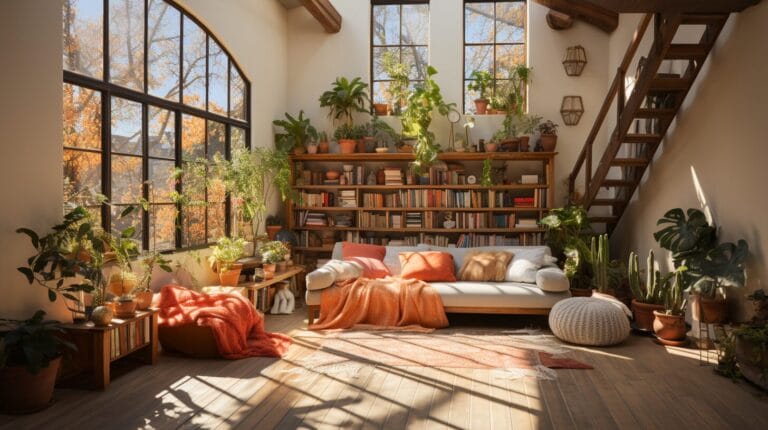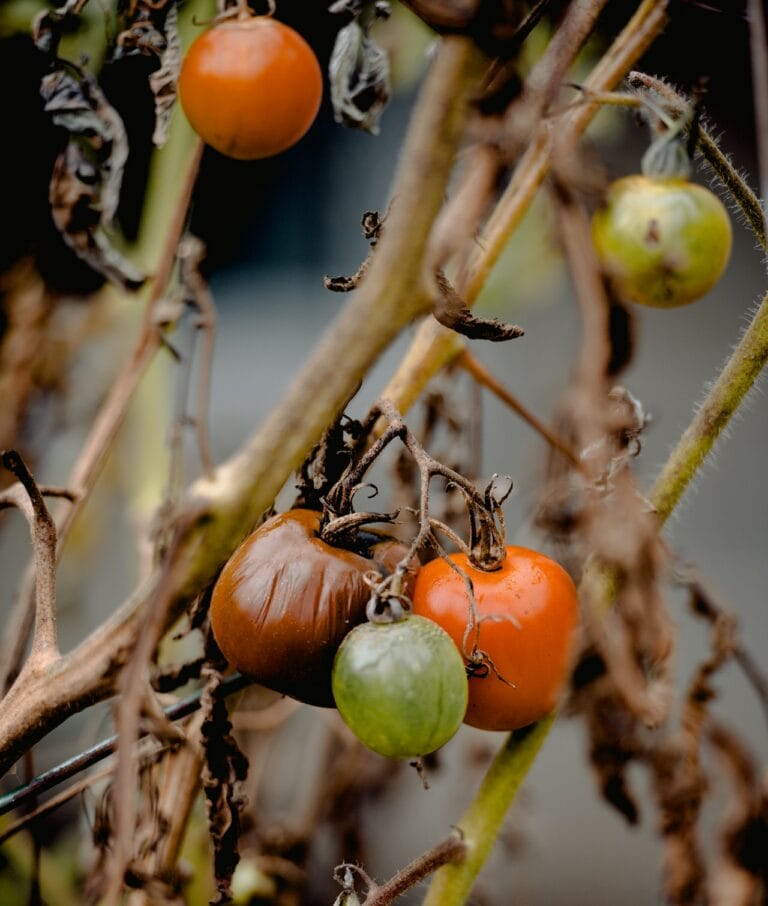Do not forsake your dream to grow your own fruits and vegetables, even if you live in a compact dwelling with little or no outdoor space. All gardening enthusiasts residing in areas with confined spaces, there is still a glimmer of hope for you!
Planting carrots in pots could be your perfect solution, converting your small balcony, intimate patio, or simple windowsill into a flourishing mini garden. With some helpful advice and easy-to-follow steps, you may soon find yourself eating fresh, homegrown carrots right from your potted plants.
There’s nothing quite like the satisfaction of munching on crunchy, sweet carrots that are the fruits of your labor. The best part? Carrots don’t require extensive space because they grow vertically downward. Hence, it’s depth, not width, that you need.
So, let’s dig deeper into the breezy process of growing carrots in containers.
Key Takeaways
- Carrots can be efficiently grown in pots, perfect for those working with limited space.
- Opt for containers that are at least 12 inches deep with drainage holes to accommodate the vertical growth of carrots.
- Use organic vegetable potting soil for optimal carrot growth.
- Prepare the pot by mixing fertilizer with a soilless potting medium, then create a trench for planting the carrot seeds approximately 1/4 inch deep.
Understanding The Needs of Carrots
Carrots are root vegetables that crave sunlight, requiring at least six hours of direct sunshine each day. The soil conditions best suited to growing carrots are loose and free of rocks, sticks, or hard clods, which can inhibit their growth.
Regarding water, carrots need a Goldilocks situation: not too much, not too little. Overwatering can cause seeds to rot before germination, while insufficient watering results in tough and less sweet carrots.
Similarly, feeding carrots with high nitrogen fertilizer while they’re young is not recommended, as it will result in lush foliage but tiny roots. Finally, ensure good airflow around your pots, which can prevent pests from affecting your indoor or outdoor pot-grown carrots.
Understanding Carrots Growth Requirements Video
Choosing Suitable Carrot Varieties for Pot Planting
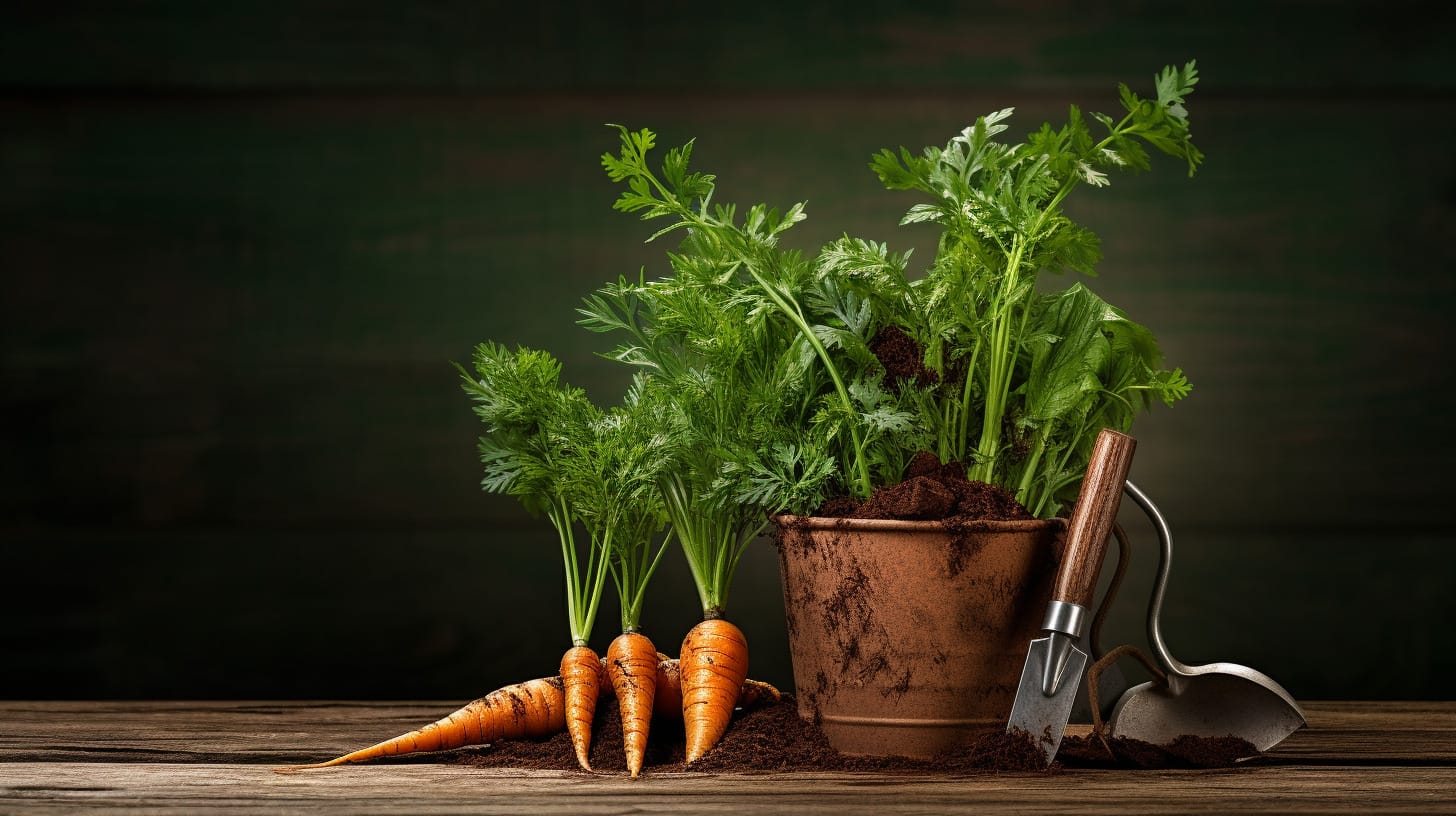
When embarking on your newfound affinity for growing carrots in containers, selecting a suitable variety is pivotal for a successful harvest. Highly recommended varieties for container growth are Yellow and Amsterdam carrots.
Choosing Carrot Varieties Video
Yellow
Yellow carrots are great for pots as they don’t require abundant space for successful growth. Frequently, they are harvested when shorter than their maximum length of 12 inches. Their sweet flavor and striking yellow coloration make a delightful and fun addition to any dish. In approximately 60 days post-planting, you can harvest your full-grown yellow carrots, making them a quick and easy choice for container gardening.
Amsterdam
Like Yellow, Amsterdam carrots also fare well in pots and require even less space. This variety matures sooner than most others, boasting a vibrant red-orange color and a short, sturdy structure. Amsterdam carrots are robust against pests and disease, simplifying their care requirements. So, if you want to grow a quick, flavorsome harvest, consider Amsterdam carrots for your container garden!
Choosing the Right Container to Grow Carrots
The decision on which pot to use is vital for healthy carrot growth. Containers should be at least 12 inches deep, providing sufficient room for carrots to expand downward. Ensure your chosen pot possesses drainage holes to prevent waterlogging, which could harm your carrots.
While some gardeners prefer light and mobile plastic pots, others lean towards clay or ceramic pots that retain moisture longer but are substantially heavier. Whichever pot type you favor, ensure it contains organic vegetable potting soil. This soil type offers the ideal conditions for carrot growth, building strong roots, fending off pests and diseases, and delivering ample nutrition.
Choosing the Right Container Video
Planting Carrots in Pots
Preparing your pot for planting is as crucial as selecting the right variety and pot for your carrots. From mixing fertilizers with soilless potting media to making a trench, each step determines your success in growing carrots.
Let’s take a closer look at these steps:
Mixing Fertilizer with Soilless Potting Media
When preparing your pot, it’s crucial to mix fertilizer with soilless potting media. This mixture provides the essential nutrients your carrots need to grow healthfully. The fertilizer adds vital nutrients like nitrogen, phosphorus, and potassium, which are vital for plant growth. On the other hand, soilless potting media offers a mixture of materials that ensure a well-drained growing medium for your carrots.
Making a Trench
Make a shallow trench, approximately 1/4 inch deep, in your pot’s soil using your fingers or a small gardening tool. This depth offers enough space for the seeds to germinate and grow without overcrowding. Once the trench is ready, sprinkle your carrot seeds along the length and cover lightly with soil. Lastly, gently pat the soil down to foster good seed-to-soil contact, watering the area thoroughly to activate germination and promote healthy growth.
Sowing and Covering Carrot Seeds
Sowing carrot seeds involves lightly scattering them over pre-moistened soil without worrying about perfect spacing at this stage, as thinning out will happen later. Subsequently, cover the seeds with a thin soil layer approximately 1/4 inch deep. Lightly pat down the soil, ensuring good seed-soil contact, and spritz your newly planted seeds with water to anchor them in.
Maintain the soil’s even moisture during germination, watering regularly and refraining from allowing it to dry out entirely.
Watering and Covering for Germination
To ensure successful germination, consistent watering and light covering are necessary. Carrot seeds require consistent moisture to sprout, so the soil should be kept moist but not overly watered.
After sowing the carrot seeds, lightly cover them with roughly 1/4 inch of soil or vermiculite. This preserves moisture levels while providing the seeds with enough light to germinate.
Meanwhile, monitor the moisture levels throughout the germination period. Gently mist the soil with water using a fine spray bottle if the top layer appears dry.
Carrots in Pots: The Care Guide
Thinning Seedlings
Thinning seedlings is an integral aspect of growing potted carrots since it gives the remaining seedlings enough growth space. Thinning helps prevent overcrowding, leading to stunted growth or misshapen carrots. It allows the roots to spread and gives each carrot plant room to develop properly.
Keeping the Soil Well-Watered and Fed
Regular watering is paramount to ensure your carrots thrive, considering carrots grow well in containers with limited moisture access. Therefore, avoid overhydrating your plants and ensure the soil remains moist, not sodden. Feeding your carrots with a balanced vegetable fertilizer will provide the required nutrients for healthy growth.
Managing Pests and Diseases
Though container-grown carrots are generally less prone to pests and diseases, it’s still prudent to stay vigilant for potential issues like common pests such as the carrot fly and diseases like Alternaria and bacterial leaf blight. Look out for signs of pest infestation or diseases, taking appropriate measures to manage them and ensure a healthy crop.
Reaping the Harvest of Your Potted Carrots
Harvesting your potted carrots can be exhilarating and gratifying. Typically, your carrots should be set for reaping approximately 60 to 80 days post-planting. You can easily spot matured carrots as their lush-green tops and substantial shoulders protrude, indicative of their wholesome growth underground.
Gently loosen the soil surrounding each carrot plant using a garden fork or a small shovel. Be careful not to damage or break any roots. Then, slowly pull each carrot out by firmly yet gently grasping its top, where it emerges from the soil.
Inspect the reaped carrots for abnormal shapes or damages. Damaged or deformed ones won’t be sustainable for long. Rinse off any remaining dirt from your carrots cautiously without scrubbing their beautiful skins vigorously. Trim off any remaining greens near carrot tops to prolong their fresh state during storage.
Preparing for the Next Crop Cycle
Even as you enjoy the fruits of your labor, preparing for the next carrot future is essential.
- Remove all matured carrots: This creates room for the new seedlings and avoids overcrowding.
- Loosen the soil: Aerates the soil, setting a conducive environment for fresh crops.
- Add compost or organic matter: This replenishes the soil nutrients for the next plant growth.
- Water thoroughly: Hydrating the soil prepares it for the next sowing session.
- Sow new carrot seeds: Follow the package instructions for the appropriate carrot seeds to sow.
- Cover lightly with soil: Ensure the seeds are not buried deeply; carrot seeds require light for germination.
- Regular watering: Consistent moisture promotes successful carrot production.
- Thin seedlings, if required: Prevent overcrowding by thinning out seedlings that are too close to one another.
- Monitor pests and diseases: Prevent common carrot pests like aphids or leafhoppers and diseases like black rot or leaf blight.
- Continue caring for your carrots: Regular watering and appropriate fertilization should be continued.
How Can Mushroom Compost Benefit Carrots Grown in Pots?
Using mushroom compost pros and cons, it is clear that this form of compost can greatly benefit carrots grown in pots. The high nutrient content of mushroom compost provides essential elements for carrot growth. It also helps improve soil structure, retains moisture, and promotes healthy root development. However, it is vital to remember that mushroom compost can be high in salts, which may require flushing with water to prevent damage to the carrot plants. Overall, when used correctly, mushroom compost can enhance the growth of carrots in potted environments.
Tips for Successful Carrot Container Growing
Monitoring Soil Moisture
Regular soil moisture monitoring is crucial for successful carrot growth in containers. Carrots require consistent moisture for best growth and tasty roots. Checking the soil moisture level is as simple as dipping your finger one inch into it. If the soil feels dry, it’s time to water your plants.
Watering at the Soil Level
Watering at the soil level, meaning directly onto the soil rather than the leaves, provides necessary moisture to the roots of your carrots. This protects the plant from overwatering or underwatering.
Appropriate Fertilizing
Proper fertilizing of container-grown carrots ensures healthy growth and abundant yields. Low-nitrogen vegetable fertilizers or compost tea are good sources of much-needed nutrients.
Thinning and Hilling Techniques
Thinning and hilling are essential techniques for growing carrots in containers. Thus, after thinning seedlings, it is recommended to gently mound up soil around the base of each carrot plant without covering the foliage. These techniques are primarily aimed at ensuring robust and healthy carrot growth.
Having mastered the art of planting carrots in pots, you might now wonder: are cement pots good for plants? Let’s delve into the benefits and considerations of using cement pots for your home garden.
Conclusion
In summary, planting carrots in containers is a brilliant alternative for those with limited space. Start experiencing the joy of digging into homegrown, delicious carrots by simply choosing the right container and soil. By following the advice laid out in this guide, you could find yourself with a bountiful harvest.
FAQs
Can I grow carrots in a pot or container?
Absolutely! Carrots can be grown indoors or outdoors using pots or containers.
What materials do I need to plant carrot seeds?
Large well-draining containers, quality potting soil, your preferred carrot seeds, and water are the primary materials for growing carrot seeds.
What type of soil is suitable for carrot plants?
Carrots thrive best in soil that remains moist but not overly wet; compost or fertile potting soil helps maintain the balance.
Are there various types of carrots to plant in containers?
Yes! Numerous carrot varieties are suitable for container planting, like round baby carrots, and some types can even help deter pests!
When is it time to harvest homegrown potted carrots?
The reaping timeline relies on the type of carrot grown. For instance, ‘Amsterdam’ Carrots mature earlier than a ‘Danvers’ Carrot variety typically does.
Does urban gardening include vegetables like potted carrots being grown?
Of course! The simplicity and ease of growing vegetables like carrots at home make them an ideal selection for urban dwellers dealing with limited space.



